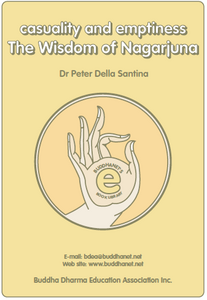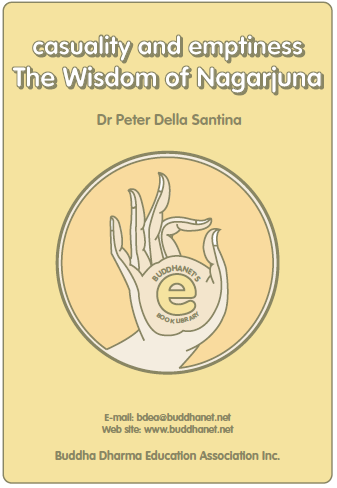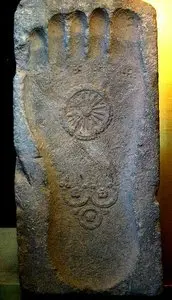"Causality and Emptiness: The Wisdom of Nagarjuna" by Peter Della Santina
Buddhist Research Society | 2002 | ISBN: 9810456573 | 190 pages | pdf | 2 Mb
Buddhist Research Society | 2002 | ISBN: 9810456573 | 190 pages | pdf | 2 Mb
"'Everything exists': That is one extreme. 'Everything doesn't exist': That is a second extreme. Avoiding these two extremes, the Tathagata teaches the Dhamma via the middle…"
Nagarjuna
Nagarjuna was an Indian philosopher who founded the Madhyamaka school of Mahāyāna Buddhism.
His writings are the basis for the formation of the Madhyamaka school, which was transmitted to China under the name of the Three Treatise (Sanlun) School. He is credited with developing the philosophy of the Prajnaparamita sutras, and was closely associated with the Buddhist university of Nalanda. In the Jodo Shinshu branch of Buddhism, he is considered the First Patriarch.
Little is known about the actual life of the historical Nagarjuna. The two most extensive biographies of Nagarjuna, one in Chinese and the other in Tibetan, were written many centuries after his life and incorporate material seen by some as historically unreliable. Nagarjuna was born a Brahmin, which in his time connoted religious allegiance to the Vedas, probably into an upper-caste Brahmin family and probably in the southern Andhra region of India.
History
Very few details on the life of Nāgārjuna are known, although many legends exist. He was born in Southern India, near the town of Nagarjunakonda (నాగార్జునకొండ) in present day Nagarjuna Sagar (నాగార్జునసాగర్) in the Guntur district of Andhra Pradesh.[citation needed] According to traditional biographers and historians such as Kumarajiva, he was born into a Brahmin family, but later converted to Buddhism. This may be the reason he was one of the earliest significant Buddhist thinkers to write in classical Sanskrit rather than Pāli or Buddhist Hybrid Sanskrit.
From studying his writings, it is clear that Nāgārjuna was conversant with many of the Nikaya school philosophies and with the emerging Mahāyāna tradition. However, affiliation to a specific Nikaya school is difficult, considering much of this material is presently lost. If the most commonly accepted attribution of texts (that of Christian Lindtner) holds, then he was clearly a Māhayānist, but his philosophy holds assiduously to the non-Mahāyāna canon, and while he does make explicit references to Mahāyāna texts, he is always careful to stay within the parameters set out by the canon.
Nagarjuna may have arrived at his positions from a desire to achieve a consistent exegesis of the Buddha's doctrine as recorded in the Canon. In the eyes of Nagarjuna the Buddha was not merely a forerunner, but the very founder of the Madhyamaka system. David Kalupahana sees Nagarjuna as a successor to Moggaliputta-Tissa in being a champion of the middle-way and a reviver of the original philosophical ideals of the Buddha.
Philosophy
Nāgārjuna's primary contribution to Buddhist philosophy is in the use of the concept of śūnyatā, or "emptiness," which brings together other key Buddhist doctrines, particularly anātman (no-self) and pratītyasamutpāda (dependent origination), to refute the metaphysics of Sarvastivāda and Sautrāntika (extinct non-Mahayana schools).
For Nāgārjuna, as for the Buddha in the early texts, it is not merely sentient beings that are "selfless" or non-substantial; all phenomena are without any svabhāva, literally "own-being" or "self-nature", and thus without any underlying essence; they are empty of being independently existent; thus the heterodox theories of svabhāva circulating at the time were refuted on the basis of the doctrines of early Buddhism.
This is so because all things arise dependently: not by their own power, but by depending on conditions leading to their coming into existence, as opposed to being. Nāgārjuna was also instrumental in the development of the two-truths doctrine, which claims that there are two levels of truth in Buddhist teaching, one which is directly (ultimately) true, and one which is only conventionally or instrumentally true, commonly called upāya in later Mahāyāna writings.
Nāgārjuna drew on an early version of this doctrine found in the Kaccāyanagotta Sutta, which distinguishes nītārtha (clear) and neyārtha (obscure) terms -
By and large, Kaccayana, this world is supported by a polarity, that of existence and non-existence. But when one reads the origination of the world as it actually is with right discernment, 'non-existence' with reference to the world does not occur to one. When one reads the cessation of the world as it actually is with right discernment, 'existence' with reference to the world does not occur to one.
"By and large, Kaccayana, this world is in bondage to attachments, clingings (sustenances), and biases. But one such as this does not get involved with or cling to these attachments, clingings, fixations of awareness, biases, or obsessions; nor is he resolved on 'my self.' He has no uncertainty or doubt that just stress, when arising, is arising; stress, when passing away, is passing away. In this, his knowledge is independent of others. It's to this extent, Kaccayana, that there is right view.
"'Everything exists': That is one extreme. 'Everything doesn't exist': That is a second extreme. Avoiding these two extremes, the Tathagata teaches the Dhamma via the middle…"
Nāgārjuna differentiates between saṃvṛti (conventionally true) and paramārtha (ultimately true) teachings, but he never declares any conceptually formulated doctrines to fall in this latter category; for him, even śūnyatā is śūnyatā; even emptiness is empty. For him, ultimately,
nivṛttam abhidhātavyaṃ nivṛtte cittagocare|
anutpannāniruddhā hi nirvāṇam iva dharmatā||
The designable is ceased when the range of thought is ceased,
For phenomenality is like nirvana, unarisen and unstopped.
This was famously rendered in his tetralemma with the logical propositions:
X (affirmation)
non-X (negation)
X and non-X (both)
neither X nor non-X (neither)
Nagarjuna also taught the idea of relativity; in the Ratnāvalī, he gives the example that shortness exists only in relation to the idea of length. The determination of a thing or object is only possible in relation to other things or objects, especially by way of contrast. He held that the relationship between the ideas of "short" and "long" is not due to intrinsic nature (svabhāva). This idea is also found in the Pali Nikāyas and Chinese Āgamas, in which the idea of relativity is expressed similarly: "That which is the element of light … is seen to exist on account of [in relation to] darkness; that which is the element of good is seen to exist on account of bad; that which is the element of space is seen to exist on account of form."
For more on Nāgārjuna's philosophy, see Mūlamadhyamakakārikā.
Nagarjuna as Ayurvedic Physician
Nagarjuna was also a practitioner of Ayurveda, or traditional Indian Ayurvedic medicine. First described in the Sanskrit medical treatise entitled Sushruta Samhita (of which he was the compiler of the redaction), many of his unique conceptualizations, such as his descriptions of the circulatory system and blood tissue (uniquely described as rakta dhātu) and his pioneering work on the therapeutic value of specially treated minerals knowns as bhasmas, which earned him the title of the "father of iatrochemistry," are described by Frank John Ninivaggi in his text: Ayurveda: A Comprehensive Guide to Traditional Indian Medicine for the West, p. 23. (Praeger/Greenwood Press, 2008).
Iconography
Nāgārjuna is often depicted in composite form comprising human and naga characteristics. Often the naga aspect forms a canopy crowning and shielding his human head. The notion of the naga is found throughout Indian religious culture, and typically signifies an intelligent serpent or dragon, who is responsible for the rains, lakes and other bodies of water. In Buddhism, it is a synonym for a realized arhat, or wise person in general. The term also means "elephant".
No Pass, Please Review
Thank U ;)
Thank U ;)











